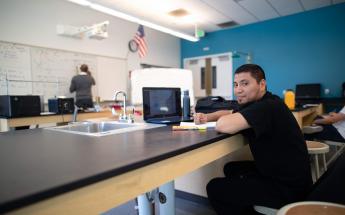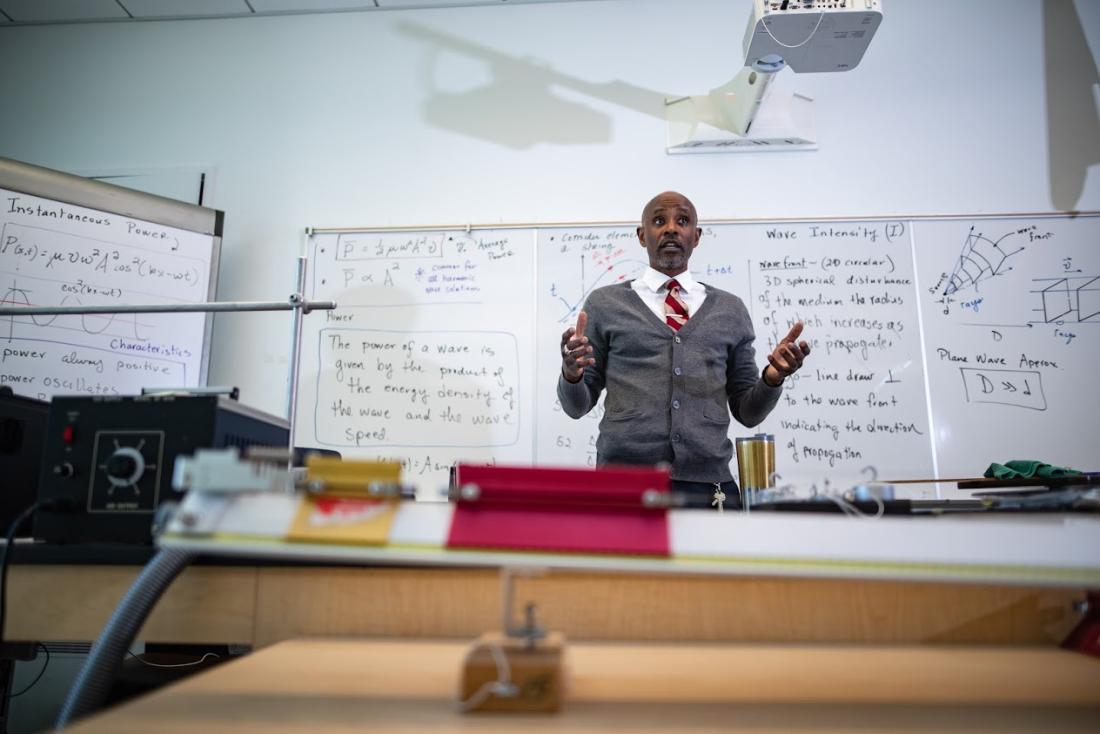Physics (AS)
Careers in Physics
Those wanting to pursue physics-based careers right after getting an associate degree often become technicians and assistants in private and public sectors.
Here are some careers and their salaries you could have with a physics degree:
Career information below taken from bls.gov November 2019. Go to bls.gov for most current career information.
Provide help and advice to computer users and organizations.
Data for Los Angeles/Long Beach/Anaheim
| Typical Education Level: | Salary: | Hourly Median Wage: |
| Some College through Bachelor's Degree | $61,800/year | $29.71/hour |
| Work Experience in a Related Occupation: | Job Outlook 2018-2028: | Number of Jobs 2018: |
| None needed | 4% increase (as fast as average) | 29,630 |
Teach academic lessons and various skills that students will need to attend college and to enter the job market.
Data for High School Teachers in all subjects for Los Angeles/Long Beach/Anaheim
| Typical Education Level: | Salary | Hourly Median Wage: |
| Bachelor’s Degree | $80,330/year | $38.62/hour |
| Work Experience in a Related Occupation: | Job Outlook 2018-2028: | Number of Jobs 2018: |
| None needed | 5% increase (as fast as average) | 41,490 |
Operate, install, calibrate, and maintain integrated computer / communications systems, consoles, simulators, and other data acquisition, test, and measurement instruments and equipment, which are used to launch, track, position, and evaluate air and space vehicles. May record and interpret test data.
Data for Los Angeles/Long Beach/Anaheim
| Typical Education Level: | Salary: | Hourly Median Wage: |
| Associate Degree | $70,740/year | $34.01/hour |
| Work Experience in a Related Occupation: | Job Outlook 2018-2028: | Number of Jobs 2018: |
| None needed | 6% increase (as fast as average) | 420 |
Assist industrial engineers in creating systems that integrate workers, machines, materials, information, and energy to make a product or provide a service.
Data for Los Angeles/Long Beach/Anaheim
| Typical Education Level: | None needed | Hourly Median Wage: |
| Associate Degree | $73,880/year | $35.52/hour |
| Work Experience in a Related Occupation: | Job Outlook 2018-2028: | Number of Jobs 2018: |
| None needed | 1% increase (little or no change) | 1,510 |
Design, create, and modify Web sites. Analyze user needs to implement Web site content, graphics, performance, and capacity. May integrate Web sites with other computer applications. May convert written, graphic, audio, and video components to compatible Web formats by using software designed to facilitate the creation of Web and multimedia content.
Data for Los Angeles/Long Beach/Anaheim
| Typical Education Level: | Salary: | Hourly Median Wage: |
| Associate Degree | $69,020/year | $33.18/hour |
| Work Experience in a Related Occupation: | Job Outlook 2018-2028: | Number of Jobs 2018: |
| None needed | 9% increase (faster than average) | 7,110 |
Assist social scientists in laboratory, survey, and other social science research. May help prepare findings for publication and assist in laboratory analysis, quality control, or data management.
Data for Los Angeles/Long Beach/Anaheim
| Typical Education Level: | Salary: | Hourly Median Wage: |
| Associate Degree | $44,270/year | $21.28/hour |
| Work Experience in a Related Occupation: | Job Outlook 2018-2028: | Number of Jobs 2018: |
| Less than one year | 1% increase (little or no change) | 810 |
What You’ll Learn at LASC in Physics
You can get Associate in Science (AS) or an Associate in Science for Transfer (AST) degree through LASC’s Physics program where you will develop your foundation in understanding the basic principles of physics, how to problem-solve logically and scientifically:
- Hone your critical-thinking, logical, and analytical skills and develop your curiosity for how things work and how to find solutions to everyday problems.
- Solve mechanical and electrical problems related to the motion of electromagnetism, dynamics, Newton’s laws, and others.
- Learn about the uses of physics in areas such as medicine, dentistry, architecture, and others where it has improved our lives and made society safer.
- LASC provides internships so you can build your career connections and create community ties for after you graduate.
- Want to transfer? Check out LASC’s Associate in Science in Physics for Transfer (AST) degree where you will save money on your first two years of college learning from passionate, innovative faculty. You can graduate with guaranteed admission into a CSU, and some UCs. Visit your counselor for details.
Degrees & Courses You Will Take
Review LASC’s Associate in Science (AS) and Associate in Science for Transfer (AST) degrees in Physics below, and our suggested course of study for these programs. Go to LASC’s current Course Catalog for specific course information:
Major Code: 1902.00
Total Units Required: 60
After you complete this program, you will be able to:
| Required Courses | TOTAL UNITS |
|---|---|
| CHEM 101 General Chemistry I | 5 |
| CHEM 102 General Chemistry II | 5 |
| MATH 260 Pre-Calculus | 5 |
| MATH 265 Calculus with Analytic Geometry I | 5 |
| MATH 266 Calculus with Analytic Geometry II | 5 |
| MATH 267 Calculus with Analytic Geometry III | 5 |
| MATH 270 Linear Algebra | 3 |
| MATH 275 Ordinary Differential Equations | 3 |
| PHYSICS 37 Physics for Engineers and Scientists I | 5 |
| PHYSICS 38 Physics for Engineers and Scientists II | 5 |
| PHYSICS 39 Physics for Engineers and Scientists III | 5 |
| TOTAL UNITS | 51 |
- Solve kinematic problems (mechanical and electrical) (90%) using equations of dynamics, work-energy relation, electromagnetism, and Newton's laws.
- Explain apparently obvious real-life (physical) phenomena (90%) using basic laws of Physics.
- Understand the technologies (80%) based on Physics and employed in specified fields like medicine, dentistry, architecture etc.
- Have developed logical thinking together with scientific approaches to problem solving.
The intent of the Associate in Science in Physics for Transfer Degree is to help you in seamlessly transferring to a CSU or possibly a UC.
If you are interested in completing an Associate Degree for Transfer, you must:
- Complete 60-semester units of 90-quarter units that are eligible for transfer to the California State University, including both of the following: *
- The Intersegmental General Education Transfer Curriculum (IGETC) or the California State University General Education-Breadth Requirements
- A minimum of 18-semester units or 27 quarter units in a major or area of emphasis, as determined by the community college district.
- Minimum 24 units in the major
*As required by Senate Bill (SB) 1440 and the California Education Code (CEC) section 66746 - Obtainment of a minimum grade point average of 2.0. ADTs also require that students must earn a C or better in all courses required for the major area of emphasis. A “P” (Pass) grade is not an acceptable grade for courses in the major. Students should meet with a counselor to determine the necessary course work to complete the general education requirements.
Required Courses Units PHYSICS 37 Physics for Engineers and Scientists I 5 PHYSICS 38 Physics for Engineers and Scientists II 5 PHYSICS 39 Physics for Engineers and Scientists III 5 MATH 265 Calculus with Analytic Geometry I 5 MATH 266 Calculus with Analytic Geometry II 5 TOTAL UNITS 25
Get Ready Before You Start
Want to be a physicist? You can start preparing for your career before your first class starts at LASC:
- Make an appointment with your LASC academic counselor to review LASC’s program, start to develop a Student Education Plan (SEP), and discuss if attending a four-year college or university would be a good match for your academic and career goals.
- Still in high school? Take as many math courses as you can, and make sure you have a good understanding of them. If needed, find a tutor to help you understand them better. Look into which aspect of physics you would like to study, and contact local businesses in that field to see if you could be an intern there. If you’re interested in astronomy, try to visit the Griffith Observatory or other observatories to learn more.
- Once you’re at LASC, make sure to get involved with off- and on-campus clubs and organizations, such as Phi Thetta Kappa, Poetry Collective, and Toastmasters, or become a student ambassador or run for student body government. These create new relationships and show potential universities and employers your commitment to being involved in your community and having diverse interests.
Program Learning Outcomes

As a student, once you graduate from this program, you should be able to:
- Solve kinematic problems (mechanical and electrical) (90%) using equations of dynamics, work-energy relation, electromagnetism, and Newton's laws.
- Explain apparently obvious real-life (physical) phenomena (90%) using the basic laws of Physics.
- Understand the technologies (80%) based on Physics and employed in specified fields like medicine, dentistry, architecture etc.
- Have developed logical thinking together with scientific approaches to problem-solving.
